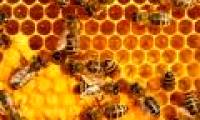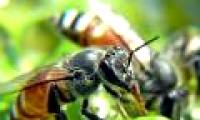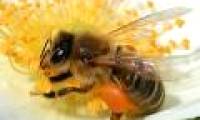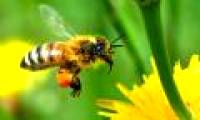
When studying African elephants, zoologists have found a way to prevent these giant animals from attacking forested villages and destroying crops. It is the honeycomb fence, the

In honey bee society, a few larvae are chosen as queen bees and the majority of them are worker bees, that is the study just published in the Journal of Proteome Research.

Researchers at the University of Illinois, USA, discovered intestinal enzymes of honey bees that can neutralize poisons of pesticides commonly used to kill ticks in honeybees.

The sudden death of the millions of millions of bees in many parts of the world in the same period of time is the old story many years ago. People again make assumptions of

Nobody works well when tired, and insects are no exception. Like humans, bees when sleepiness becomes a bad dancer and a poor communicator, according to New Scientist magazine.

Research shows that roots of vegetables have collective intelligence, like honey bees and humans, that share information and solve problems together.

Scientists have discovered honeybee populations of more than 10,000 years old, isolated in an oasis of northern Sahara, the world's largest desert.

After discovering hidden flowers that contain hazards, honeybees fly to the nest and perform a dance to warn of their fellow humans.

The phenomenon of hundreds or even thousands of giant honey bees tossing their belly up in just about a second of a second to create a wave of Mexican Wave in the hives has

Most people think before making a decision, for bees as well. According to a Nature article, Israeli researchers have shown that when deciding, people and bees share a reckless
 When studying African elephants, zoologists have found a way to prevent these giant animals from attacking forested villages and destroying crops. It is the honeycomb fence, the
When studying African elephants, zoologists have found a way to prevent these giant animals from attacking forested villages and destroying crops. It is the honeycomb fence, the In honey bee society, a few larvae are chosen as queen bees and the majority of them are worker bees, that is the study just published in the Journal of Proteome Research.
In honey bee society, a few larvae are chosen as queen bees and the majority of them are worker bees, that is the study just published in the Journal of Proteome Research. Researchers at the University of Illinois, USA, discovered intestinal enzymes of honey bees that can neutralize poisons of pesticides commonly used to kill ticks in honeybees.
Researchers at the University of Illinois, USA, discovered intestinal enzymes of honey bees that can neutralize poisons of pesticides commonly used to kill ticks in honeybees. The sudden death of the millions of millions of bees in many parts of the world in the same period of time is the old story many years ago. People again make assumptions of
The sudden death of the millions of millions of bees in many parts of the world in the same period of time is the old story many years ago. People again make assumptions of Nobody works well when tired, and insects are no exception. Like humans, bees when sleepiness becomes a bad dancer and a poor communicator, according to New Scientist magazine.
Nobody works well when tired, and insects are no exception. Like humans, bees when sleepiness becomes a bad dancer and a poor communicator, according to New Scientist magazine. Research shows that roots of vegetables have collective intelligence, like honey bees and humans, that share information and solve problems together.
Research shows that roots of vegetables have collective intelligence, like honey bees and humans, that share information and solve problems together. Scientists have discovered honeybee populations of more than 10,000 years old, isolated in an oasis of northern Sahara, the world's largest desert.
Scientists have discovered honeybee populations of more than 10,000 years old, isolated in an oasis of northern Sahara, the world's largest desert. After discovering hidden flowers that contain hazards, honeybees fly to the nest and perform a dance to warn of their fellow humans.
After discovering hidden flowers that contain hazards, honeybees fly to the nest and perform a dance to warn of their fellow humans. The phenomenon of hundreds or even thousands of giant honey bees tossing their belly up in just about a second of a second to create a wave of Mexican Wave in the hives has
The phenomenon of hundreds or even thousands of giant honey bees tossing their belly up in just about a second of a second to create a wave of Mexican Wave in the hives has Most people think before making a decision, for bees as well. According to a Nature article, Israeli researchers have shown that when deciding, people and bees share a reckless
Most people think before making a decision, for bees as well. According to a Nature article, Israeli researchers have shown that when deciding, people and bees share a reckless









 Why did the ancient Babylonian civilization perish? Was it because they considered 'that thing' a daily meal?
Why did the ancient Babylonian civilization perish? Was it because they considered 'that thing' a daily meal? Just discovered a 72km 'tear in the Earth', the world's second largest country is in fear of a tsunami attack
Just discovered a 72km 'tear in the Earth', the world's second largest country is in fear of a tsunami attack Top 7 facts about the hottest place in the world, where you can fry eggs at outdoor temperature
Top 7 facts about the hottest place in the world, where you can fry eggs at outdoor temperature The Qing Dynasty collapsed, what surname did 20,000 royal descendants change to to integrate into the new era?
The Qing Dynasty collapsed, what surname did 20,000 royal descendants change to to integrate into the new era? After 389 days in the Arctic, costing more than $160 million, hundreds of scientists brought back bad news: What was it?
After 389 days in the Arctic, costing more than $160 million, hundreds of scientists brought back bad news: What was it? How long does it take to fall in love with someone?
How long does it take to fall in love with someone? How much silver has ever been discovered in the world?
How much silver has ever been discovered in the world? How does an atomic bomb work?
How does an atomic bomb work?